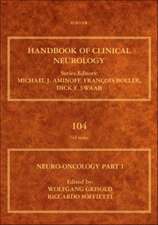The Cancer Degradome: Proteases and Cancer Biology
Editat de Dylan Edwards, Gunilla Hoyer-Hansen, Francesco Blasi, B.F. Sloaneen Limba Engleză Hardback – 19 sep 2008
| Toate formatele și edițiile | Preț | Express |
|---|---|---|
| Paperback (1) | 1447.17 lei 6-8 săpt. | |
| Springer – 23 aug 2016 | 1447.17 lei 6-8 săpt. | |
| Hardback (1) | 1453.74 lei 6-8 săpt. | |
| Springer – 19 sep 2008 | 1453.74 lei 6-8 săpt. |
Preț: 1453.74 lei
Preț vechi: 1530.25 lei
-5% Nou
Puncte Express: 2181
Preț estimativ în valută:
278.20€ • 302.09$ • 233.69£
278.20€ • 302.09$ • 233.69£
Carte tipărită la comandă
Livrare economică 22 aprilie-06 mai
Preluare comenzi: 021 569.72.76
Specificații
ISBN-13: 9780387690568
ISBN-10: 0387690565
Pagini: 926
Ilustrații: XXIV, 926 p. 90 illus., 33 illus. in color. With 2 16-page inserts.
Dimensiuni: 155 x 235 x 49 mm
Greutate: 1.51 kg
Ediția:2009
Editura: Springer
Colecția Springer
Locul publicării:New York, NY, United States
ISBN-10: 0387690565
Pagini: 926
Ilustrații: XXIV, 926 p. 90 illus., 33 illus. in color. With 2 16-page inserts.
Dimensiuni: 155 x 235 x 49 mm
Greutate: 1.51 kg
Ediția:2009
Editura: Springer
Colecția Springer
Locul publicării:New York, NY, United States
Public țintă
ResearchCuprins
The Degradome and Its Analysis.- Protease Genomics and the Cancer Degradome.- The CLIP-CHIP™: A Focused Oligonucleotide Microarray Platform for Transcriptome Analysis of the Complete Human and Murine Cancer Degradomes.- The Hu/Mu ProtIn Chip: A Custom Dual-Species Oligonucleotide Microarray for Profiling Degradome Gene Expression in Tumors and Their Microenvironment.- Quantitative Real-Time PCR Analysis of Degradome Gene Expression.- Identification of Protease Substrates by Mass Spectrometry Approaches-1.- Identification of Protease Substrates by Mass Spectrometry Approaches-2.- Activity-Based Imaging and Biochemical Profiling Tools for Analysis of the Cancer Degradome.- Images of Cleavage: Tumor Proteases in Action.- Insights into Protease Function.- Proteolytic Pathways: Intersecting Cascades in Cancer Development.- Physiological Functions of Plasminogen Activation: Effects of Gene Deficiencies in Humans and Mice.- The Plasminogen Activation System in Tissue Remodeling and Cancer Invasion.- The Urokinase Plasminogen Activator Receptor as a Target for Cancer Therapy.- The Endocytic Collagen Receptor, uPARAP/Endo180, in Cancer Invasion and Tissue Remodeling.- Physiological and Pathological Functions of Type II Transmembrane Serine Proteases: Lessons from Transgenic Mouse Models and Human Disease-Associated Mutations.- Roles of Cysteine Proteases in Tumor Progression: Analysis of Cysteine Cathepsin Knockout Mice in Cancer Models.- In Vitro and In Vivo Models of Angiogenesis to Dissect MMP Functions.- The Surface Transplantation Model to Study the Tumor–Host Interface.- Unravelling the Roles of Proteinases in Cell Migration In Vitro and In Vivo.- New Insights into MMP function in Adipogenesis.- TIMPs: Extracellular Modifiers in Cancer Development.- The InterfaceBetween Proteolysis and Cell Signalling.- Invadopodia: Interface for Invasion.- uPAR and Proteases in Mobilization of Hematopoietic Stem Cells.- The Urokinase Receptor and Integrins Constitute a Cell Migration Signalosome.- Measuring uPAR Dynamics in Live Cells.- Janus-Faced Effects of Broad-Spectrum and Specific MMP Inhibition on Metastasis.- Cytokine Substrates: MMP Regulation of Inflammatory Signaling Molecules.- Matrix Metalloproteinases as Key Regulators of Tumor–Bone Interaction.- The Degradome as Source of Cancer Diagnostic and Markers.- The Plasminogen Activation System as a Source of Prognostic Markers in Cancer.- Cysteine Cathepsins and Cystatins as Cancer Biomarkers.- Novel Degradome Markers in Breast Cancer.- Meta-Analysis of Gene Expression Microarray Data: Degradome Genes in Healthy and Cancer Tissues.- Degradome Gene Polymorphisms.- TIMP-1 as a Prognostic Marker in Colorectal Cancer.- Novel Therapeutic Strategies.- Structure and Inhibition of the Urokinase-Type Plasminogen Activator Receptor.- Engineered Antagonists of uPA and PAI-1.- MMP Inhibitor Clinical Trials – The Past, Present, and Future.- Tailoring TIMPs for Selective Metalloproteinase Inhibition.- Third-Generation MMP Inhibitors: Recent Advances in the Development of Highly Selective Inhibitors.- Protease-Activated Delivery and Imaging Systems.- Development of Tumour-Selective and Endoprotease-Activated Anticancer Therapeutics.- Targeting Degradome Genes via Engineered Viral Vectors.
Textul de pe ultima copertă
Proteases that act in the extracellular environment have been historically associated with tumorigenesis and metastasis by virtue of their ability to carry out "path-clearing" for cancer cells. In the past few years it has become clear that they also shape the pericellular signaling environment, with profound consequences for cell fate and phenotype in both normal development and disease states. The repertoire of proteases that cells and tissues coordinately regulate in order to modulate their local environment is the DEGRADOME – which in humans is represented by at least 569 proteases in five catalytic classes. "The Cancer Degradome: Proteases in Cancer Biology" , edited by Dylan Edwards, Francesco Blasi, Gunilla-Høyer-Hansen and Bonnie Sloane, covers recent knowledge of the composition of the Degradome, how it can be studied using modern approaches such as transcriptomics and mass spectrometry; how protease activity can be imaged both in vitro and in vivo; how gene knockout mice have improved our knowledge of the roles of proteases in cancer; the links that have emerged between proteolysis and cell signaling; how the Degradome can be a useful source of diagnostic and prognostic markers; and finally new approaches to target proteolysis for therapy.
Caracteristici
In the context of the battle against cancer, the Degradome is important in three principal areas: Cellular proteases and their inhibitors are components of the molecular machinery of malignancy, and thus are attractive as therapeutic targets. Importantly, we now appreciate that some proteases perform functions that antagonize tumour growth, and these are then anti-targets that must be avoided Degradome genes are valuable as prognostic and diagnostic markers of disease that can improve the accuracy of conventional clinical and histopathological assessment Cellular proteases are target molecules for improving tumour detection and imaging






